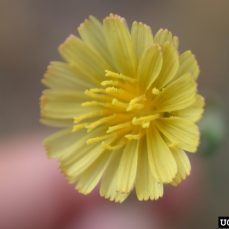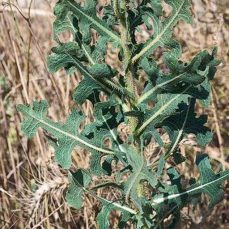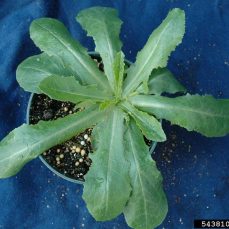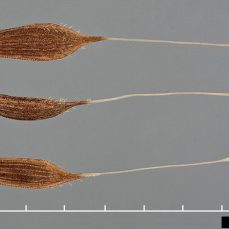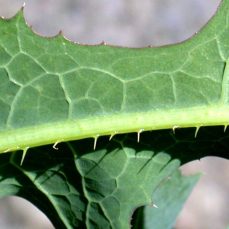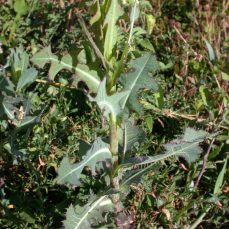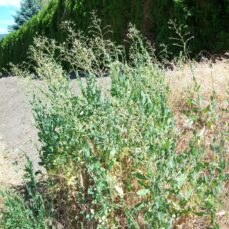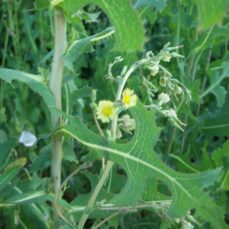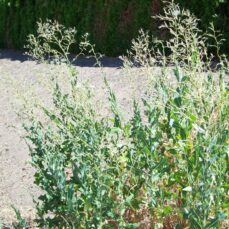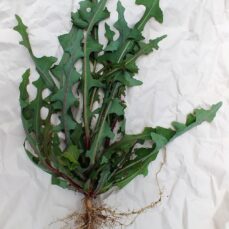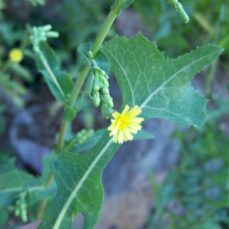Prickly Lettuce (Lactuca serriola)

Photo credit: R. Mueller
Management Strategy
Squamish
Whistler
Pemberton
Vectors of Spread
Overview
Prickly lettuce is an invasive plant within British Columbia. This invasive is a biennial weed from the daisy family (Asteraceae) that can grow up to 1.8 m tall.
Synonyms
Prickly lettuce is also known as:
- China lettuce
- Compass plant
- Wild lettuce
ID Characteristics
Flowers: A ray of 12-20 strap-shaped yellow petals. The flowers close before midday and are very small (about 3 – 4 mm in diameter). Individual flowers are similar to dandelions.
Stems: Erect, branched, and hairy stems. Every part of the plant exudes a milky sap when cut.
Leaves: Prickly lettuce emerges in autumn as a rosette of basal leaves (on the ground). In summer, a flowering stem grows with narrow, lobed, arrow-shaped leaves that grow in an alternate pattern. These leaves have spiny margins, painful to handle. Most notably, leaves have a white mid-vein, which is prickly on the underside.
Roots: Thin, branched taproot.
Fruits: Small, greyish-brown single-seed, about 3 mm long. They are thin and flattened, with a pappus (tuft of hairs).
Similar Species
Invasive:
- Annual sow thistle (Sonchus oleraceus) is also invasive; it has larger flowers than prickly lettuce.
- Perennial sow thistle (Sonchus arvensis) is another invasive plant that has larger flowers than prickly lettuce; it is also distinguishable by its rhizomes.

Photo credit: S. Dewey, Utah State University, Bugwood.org (Perennial Sow Thistle)
Exotic:
- Cultivated lettuce (Lactuca sativa L.): Although this lettuce is not native to British Columbia, it is not competitive with the native plant community. Therefore, it is classed as ‘exotic’. The key difference between Cultivated and prickly lettuce is in the leaves. Cultivated lettuce does not have prickly leaves, whereas prickly lettuce (of course) does!

Cultivated Lettuce by By Kim Starr. Copyright © 2023 CC BY 3.0.
Habitat and Origin
Prickly lettuce was introduced from Europe. Its presence dates back to the late 19th century; it is speculated that it was introduced as a contaminant in agricultural seed.
Prickly lettuce prefers dry conditions. It thrives along dry roadsides, thicket clearings, agricultural areas, abandoned fields and other disturbed areas. It is also commonly found at waste disposal sites.
How it Spreads
Prickly lettuce is a biennial weed (two-year lifespan). In the first year, it forms a rosette, which will bolt (grow a flowering stem) and go to seed the following year.
These seeds are predominately self-propagated and their pappus (tuft of hairs) allow for wind dispersal. The seeds germinate with the onset of winter rains.
The tall stalks, lightweight seeds, and parachute-like pappus (cluster of hairs) help spread the seeds in the wind. Seeds can also spread through water or attach to fur or feathers.
Impacts
Ecological
- Causes habitat loss for native flora, especially for Vancouver Island Beggarsticks (Bidens amplissima), a provincially-designated, Special Concern species.
Economic
- Reduces crop value and harvesting efficiency.
- The sticky, latex sap can clog harvesting equipment.
- Cattle that exclusively graze on young Prickly Lettuce have been reported to develop pulmonary emphysema. However, mature or dried younger plants appear to be non-toxic.
Stop the Spread
Prickly lettuce is found in the Sea to Sky region and its distribution is beyond landscape-level control. When prickly lettuce is present at high-priority locations and negatively impacting them, their control is considered a high priority.
Otherwise, the goal is to prevent it from spreading to new (uninfested) areas, and to control it where possible to limit its impact on biodiversity.
Learn to identify prickly lettuce: use the images presented on this profile page.
What to do if you spot it: you can report any prickly lettuce sighting by visiting our reporting page.
Do:
- Regularly monitor properties for weed infestations.
- Remove plant material from any equipment, vehicles or clothing used in infested areas and wash equipment and vehicles at designated cleaning sites before leaving infested areas.
- Ensure soil and gravel are uncontaminated before transport.
- Minimize soil disturbances (e.g., use grazing plants that prevent soil exposure from overgrazing), and use seed mixes with dense, early colonization (e.g., alfalfa or barley) to re-vegetate exposed soil and resist invasion.
- Ensure invasive plant (particularly flowering heads or root fragments) are bagged or covered to prevent spread during transport to designated disposal sites (e.g., landfill).
Do not:
- Plant prickly lettuce in a garden, no matter how well-contained its enclosure may seem.
- Move soil that has been contaminated with prickly lettuce.
- Unload, park, or store equipment or vehicles in infested areas; remove plant material from any equipment, vehicles, or clothing used in such areas and wash equipment and vehicles at designated cleaning sites before leaving infested areas.
- Compost prickly lettuce!
Control
Mechanical
- Prickly Lettuce is easily controlled by cultivation or pulling.
- Mowing, on the other hand, is not an effective control method because the plants will readily produce new stems or flowering branches.
- It is recommended that you wear gloves and long sleeves to remove Prickly Lettuce, as the leaves are spiked.
Chemical
- Rosettes can be killed with non-selective herbicides containing glyphosate, with larger rosettes requiring higher concentrations.
- Other effective herbicides include 2,4-D, MCPA, dicamba and clopyralid.
- Plants are difficult to control with herbicides once the flowering stems have begun to elongate.
We recommend that any herbicide application is carried out by a person holding a valid BC Pesticide Applicator Certificate. Before selecting and applying herbicides, you must review and follow herbicide labels and application rates; municipal, regional, provincial and federal laws and regulations; species-specific treatment recommendations, and site-specific goals and objectives.
Biological
There is no biocontrol available for this plant.
Sea to Sky Distribution
Prickly Lettuce Factsheet
Having trouble viewing the factsheet? Don’t worry, all the information is included on this page. You can also contact us with any questions.
References
- Centre for Invasive Species and Ecosystem Health, Prickly Lettuce (Lactuca serriola)
- Electronic Atlas of the Flora of BC, Lactuca serriola
- Global Biodiversity Information Facility, Lactuca serriola
- Government of Canada, Management Plan for the Vancouver Island Beggarticks (Bidens amplissima) in Canada, Section 8.1 (pp. 17-18)
- Government of Ontario, Prickly lettuce
- Invasive Plant Atlas of the United States, Prickly Lettuce
- Lacitic, Erik, “WSU wants to turn goo from weed prickly lettuce into rubber”, in Seattle Times (May 10, 2015)
- Minnesota Wildflowers, Lactuca serriola (Prickly Lettuce)
- National Institute of Food and Agriculture Cooperative Extension, Invasive Species: Lactuca serriola, Prickly Lettuce
- Sustainable Agriculture Research and Education Program, Manage Weeds on Your Farm: Prickly Lettuce
- University of California Agriculture and Natural Resources Integrated Pest Management Program, Prickly Lettuce
- E. Weaver and M. P. Downs, The Biology of Canadian Weeds 122: Lactuca serriola, Canadian Journal of Plant Science





